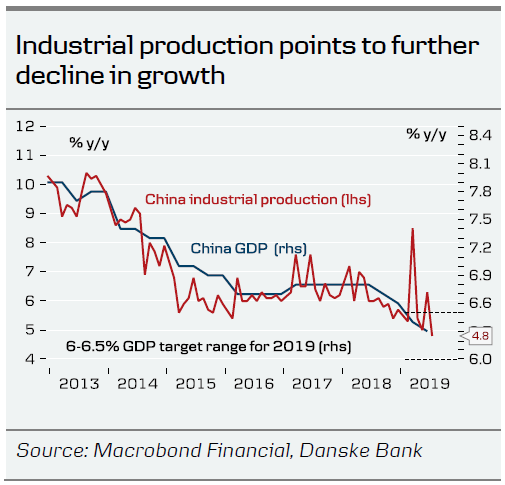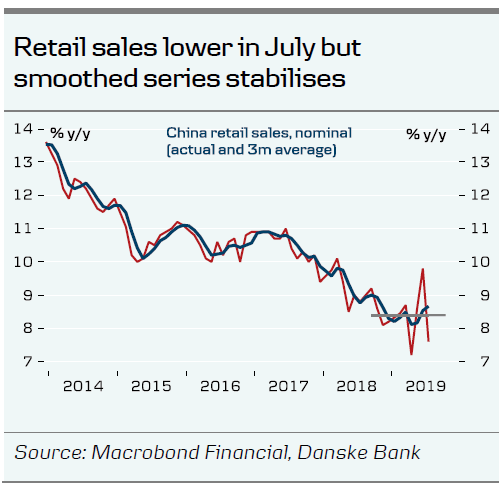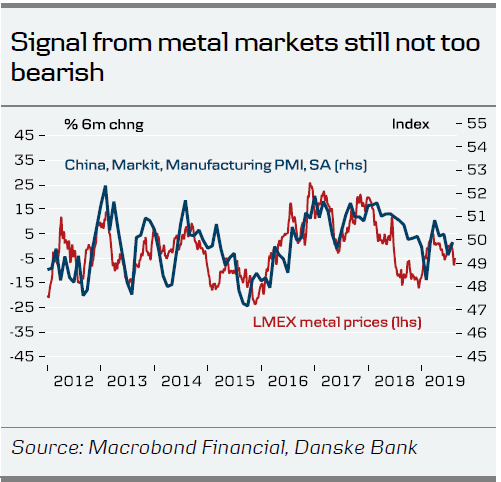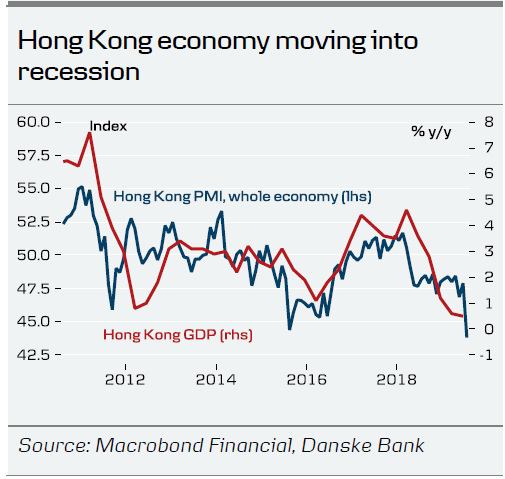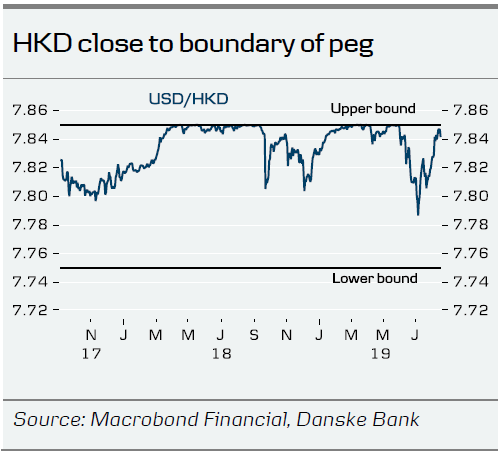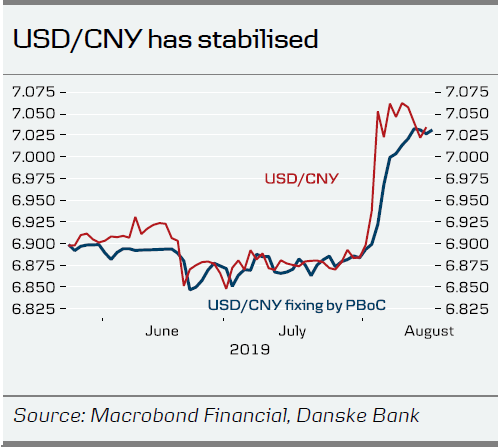- Data point to more weakness in Q3, China plans more consumer stimulus
- Hong Kong protests calm down after violence hits a new peak
- Another bumpy week in the trade war
Industrial growth lowest since 1990, more stimulus coming
Chinese data this week was soft but not a disaster. On the surface industrial production looked very weak falling to 4.8% y/y, the lowest rate since 1990. However, it still points to GDP growth around 6.2% y/y, which is within the government’s 6-6½% target range for 2019 (see chart). Retail sales growth dropped to 7.6% y/y in July from 9.8% in June. Again, not looking great on the surface. Taking a step back, though, the June level was an outlier and too good to be true. The smoothed series has moved sideways since late 2018 around 8.5% y/y. One of our favourite real time indicators, metal price inflation, indicates an only moderate decline in PMI’s from here.
On Friday, China’s state planner said that it would roll out a plan to boost disposable income this year and in 2020 to spur private consumption.
Comment: China’s economy is under pressure from the trade war but so far there are still no signs of a hard landing. Growth is still on track to reach the government’s target. However, in order to keep growth within the range China looks set to add more stimulus to consumers. This also fits with the long-term goal of consumption being a bigger growth driver and relying less on external demand.
Hong Kong protests reached a new peak
Protests in Hong Kong reached a new peak this week with violent clashes in Hong Kong airpor t. A Hong Kong policeman ended up drawing his gun after being caught in a corner with angry protesters around him. A Chinese man who turned out to be a journalist from the Chinese tabloid Global Times, was beaten and detained by protesters.
The violence led to a sharp response in China that has increasingly compared the violence to terror-like actions. All eyes have been on the thousands of troops from China’s paramilitary People’s Army Police that have moved to Shenzhen, only 30 kilometres from Hong Kong’s city centre. The crisis has now become the most discussed subject on Chinese social media. The recent violence has led to a bit of a backlash for protesters as more Hong Kong citizens have voiced opposition to the violence. 91-year old Hong Kong tycoon Li Ka-shing used newspaper ads to reject violence and suggested that further escalation could ruin Hong Kong forever.
While the protests started with demonstrations against an extradition bill, they have become more general demands for more democratic freedoms and against police violence. Protesters also want a complete withdrawal of the extradition bill, which has so far been suspended, but not completely withdrawn. Read more background here and here .
US President Donald Trump chipped in during the week in a tweet that supported Xi Jinping and ended with the words ‘Personal meeting’? It was generally understood as Trump offering to meet Xi in person to discuss it, but Trump in another tweet clarified that he referred to a personal meeting between Xi and the protesters. However, to China the Hong Kong issue is a domestic affair and they have consistently rejected what they see as foreign meddling. There is also a perception in Beijing that the US plays a role in the protests; a perception that was further fuelled by photos that showed some of the protest leaders meeting with the US Consulate General in Hong Kong.
The situation in Hong Kong has been a bit calmer in recent days and the airport is open again. On Sunday a peaceful march against police violence is planned, which will be a test of whether the violence has quieted down and protests be more peaceful.
On Wednesday, the Hong Kong government announced a stimulus package giving tax cuts to low income households. The Financial Secretary Paul Chan warned the economy could go into recession.
The HKD has weakened lately but there are no signs that the peg to the USD is seriously threatened. The Hong Kong Monetary Authority has extensive means to defend the peg. There have been signs, though, that more people have taken positions to either hedge or position for a break of the peg.
Comment: While things have calmed down a bit in the past days it is probably too early to sound the ‘all clear’. The thing to look out for is whether Beijing decides to step in, but this is in our view only likely to happen if the violence gets out of control and the Hong Kong police are not able to stop it on their own. Moving in Chinese forces would be risky in many ways: it could add fuel to the fire among protesters, China could face condemnation from Western countries and finally there would be a risk it could turn out bad and get bloody. On the HKD we do not see the peg going but there is a medium term risk for the Hong Kong economy if the situation worsens. Companies and wealthy residents would move out of Hong Kong to for example Singapore. As Hong Kong is one of the most highly valued housing markets in the world, it might not take much to set off a negative spiral in house prices that could potentially trigger a financial crisis in Hong Kong.
Trump delays tariffs while China repeats retaliation message
This week, Trump chose to delay part of the 10% tariff increase on Chinese goods due to the Christmas sales. It gave short-term relief but it was clear Trump’s move was not a game changer as China later confirmed in a statement that it planned to retaliate against any tariff increase. The US added more Chinese companies to the export blacklist, which caused more threats of countermeasures from Beijing.
Comment: It is clear that there is no progress between the two sides. Another phone call is scheduled in two weeks between negotiators and a face-to-face meeting is planned for September in Washington. Now, however, keeping the status quo and avoiding escalation is the best we can hope for, in our view. China’s retaliation could involve ‘rare earth’ metals.
Other China news this week:
Huawei launches first 5G phone in Beijing.
USD/CNY stabilises just above 7, helped by Trump’s tariff delay (see chart).
Chinese company unveils scooters that can drive themselves to charging stations.




